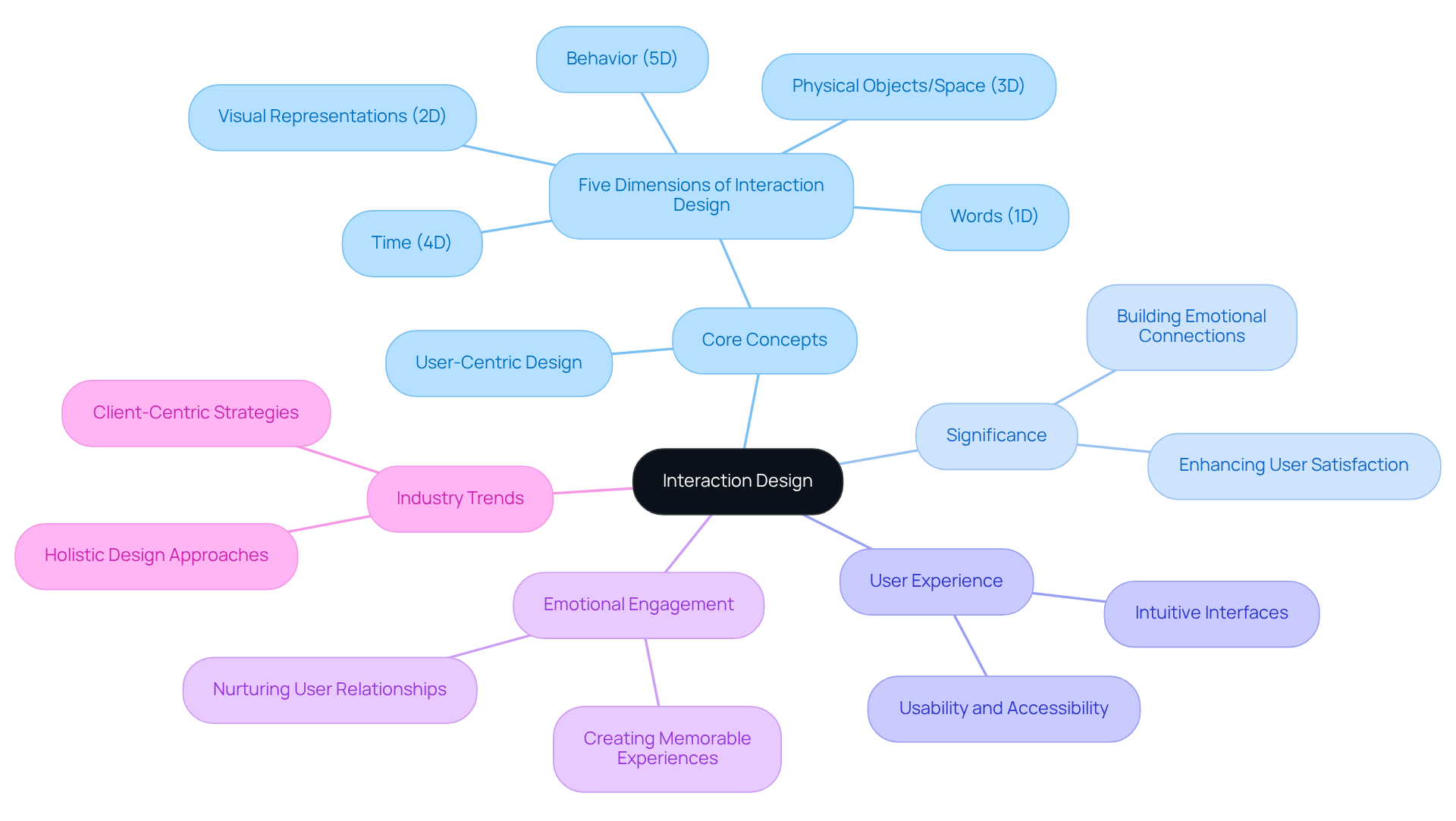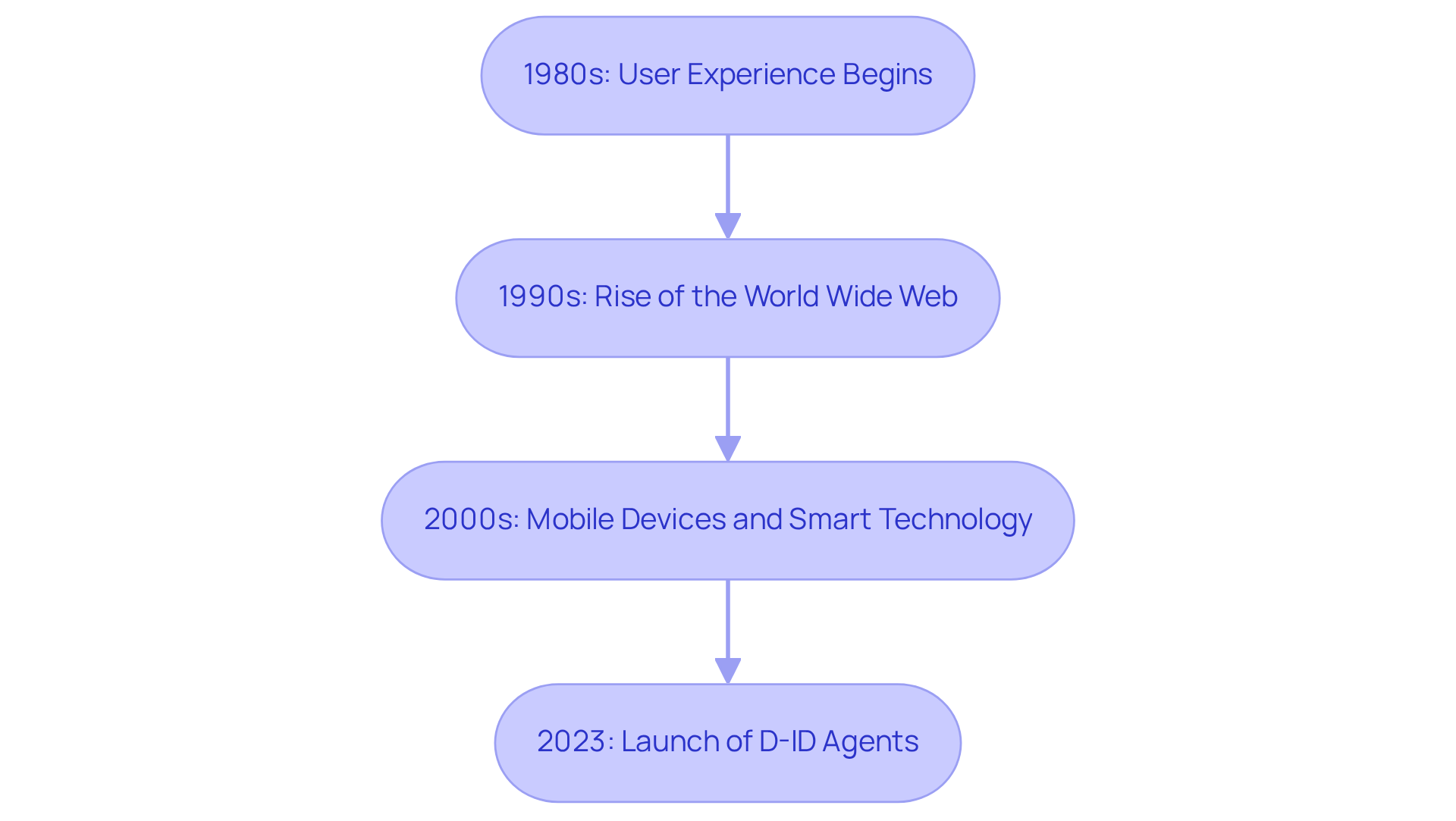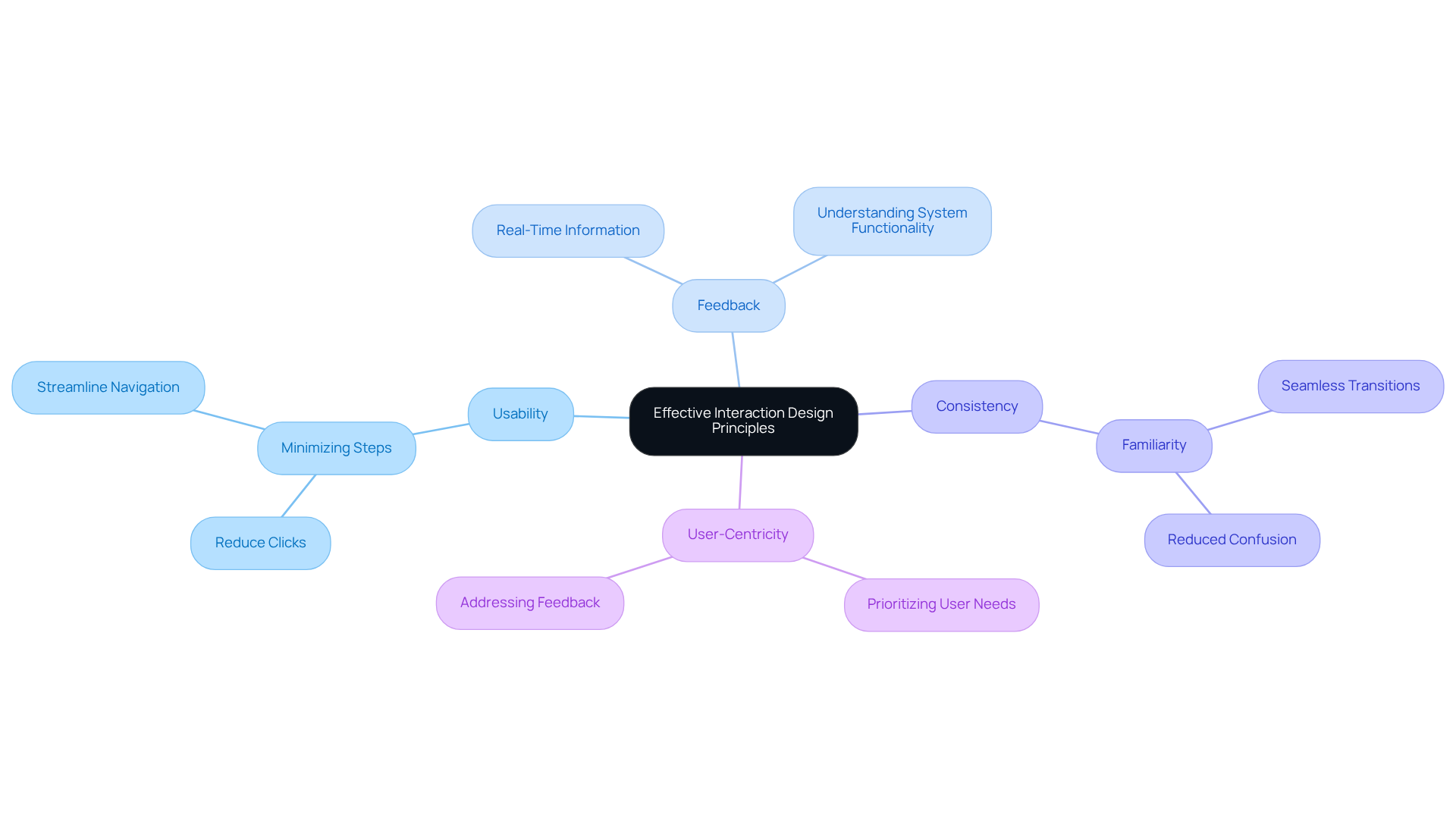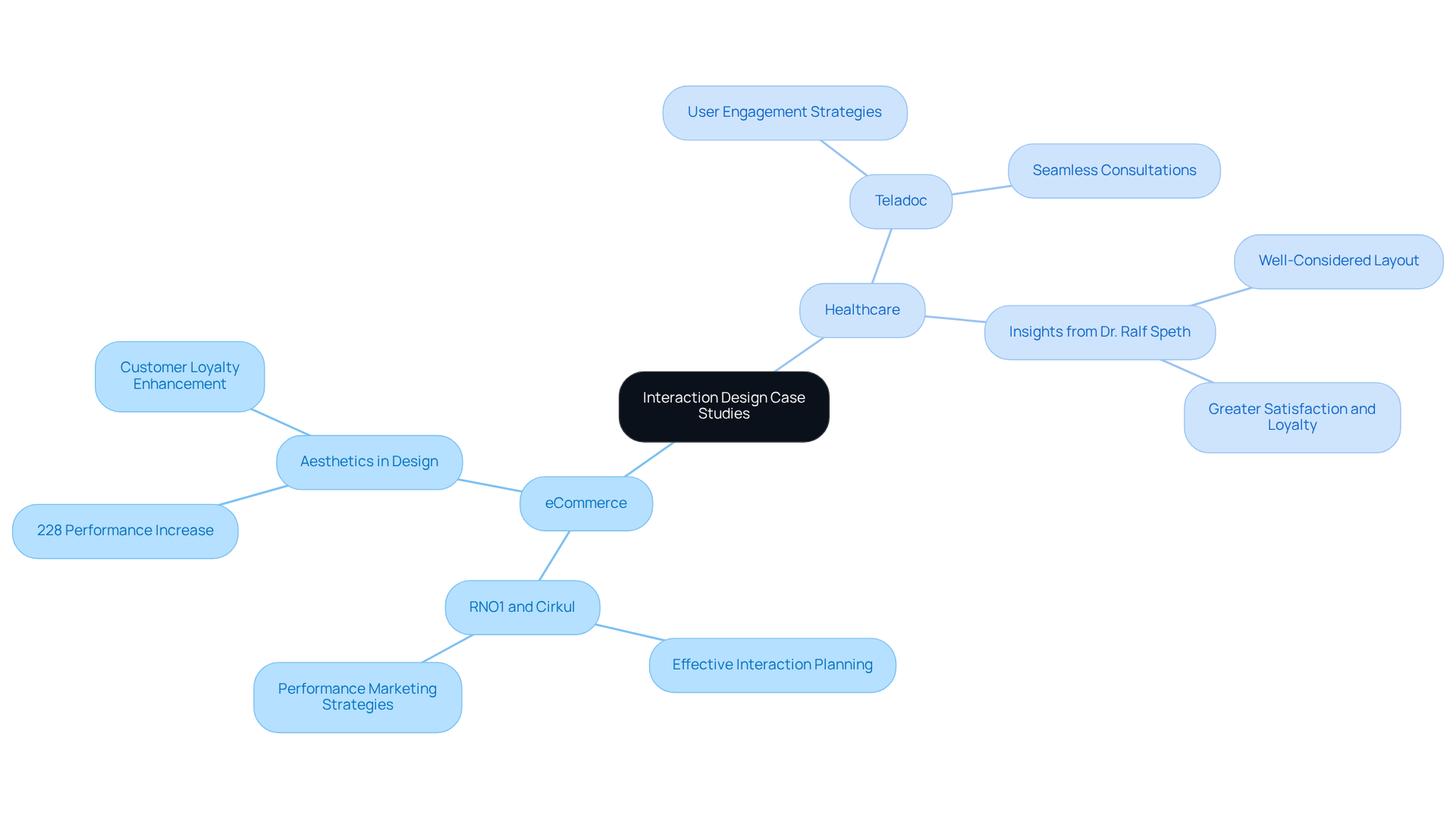Overview
Interaction design is essential in shaping the connections between users and products, systems, or services. It plays a pivotal role in enhancing engagement and satisfaction through experiences that resonate emotionally.
Many tech startup founders face the challenge of creating interfaces that not only attract users but also keep them engaged. When interactions feel clunky or disconnected, it can lead to frustration and lost opportunities for meaningful connections. This is where effective interaction design principles come into play.
Usability and user-centricity are not just buzzwords; they are vital for crafting seamless interfaces that foster emotional bonds. By focusing on these principles, businesses across sectors like eCommerce and healthcare can drive success and build lasting relationships with their users.
At RNO1, we understand these challenges and are here to support you in creating designs that resonate deeply with your audience, ensuring that every interaction is a step towards greater engagement and satisfaction.
Introduction
In today's digital age, understanding the dynamics of interaction design is more important than ever. Many of us feel overwhelmed by the rapid changes in technology and how they shape our experiences as consumers. This intricate field not only addresses the usability and functionality of products but also highlights the emotional connections we can create through thoughtful engagement.
As technology evolves, we often wonder: how can designers craft intuitive interfaces that truly resonate with users while navigating an increasingly complex digital landscape?
By exploring the principles and real-world applications of interaction design, we can appreciate not just its significance but also its transformative power across various industries. Together, we can find ways to bridge the gap between technology and human experience, fostering deeper connections in our digital world.
Define Interaction Design: Core Concepts and Significance
What is interaction design? It represents both the art and science of shaping the engagements between individuals and products, systems, or services. It’s about forming a dialogue that resonates both physically and emotionally, which illustrates what is interaction design, with the primary goal of enhancing engagement through intuitive and captivating exchanges. At RNO1, we focus on aesthetics across every touchpoint, ensuring that our solutions not only meet client needs but also foster digital growth through creative innovation.
However, understanding what is interaction design can often make the journey of engagement architecture feel overwhelming. It’s crucial to recognize what is interaction design, as it highlights its importance in enabling smooth participant journeys, allowing individuals to reach their goals efficiently and effectively. Imagine navigating a complex digital interface that feels daunting—this is where user-focused creation principles come into play. At RNO1, we have successfully transformed intricate digital interfaces into intuitive experiences that connect with individuals, nurturing emotional ties and enhancing overall satisfaction.
As digital products become increasingly complex, understanding what is interaction design becomes even more apparent, acting as a vital bridge between technology and individual needs. Recent trends indicate a shift towards more client-centric strategies, where understanding consumer behavior and preferences is paramount. Experts emphasize that what is interaction design focuses on creating effective engagement, which not only improves usability but also fosters emotional connections, ultimately enhancing satisfaction for individuals.
Consider the successful initiatives in this area; they illustrate how thoughtful engagement planning can lead to increased participant involvement, nurturing brand loyalty and contentment. Understanding what is interaction design is crucial, as the impact of interface creation extends beyond mere functionality; it shapes how individuals perceive and engage with digital products. By prioritizing the needs of individuals and adopting a holistic approach, creators can explore what is interaction design to create experiences that resonate on multiple levels, ensuring that technology feels approachable and enjoyable.
In today’s fast-paced digital landscape, where user expectations are constantly evolving, this caring approach is essential. We invite you to reflect on your experiences and share your thoughts with us, as we embark on this journey together, committed to .

Explore the Evolution of Interaction Design: Historical Context and Development
The concept of user experience began to take shape in the mid-1980s, emerging from earlier advancements in human-computer interaction (HCI). Initially, the focus was primarily on usability and functionality. However, as technology evolved, the landscape of design for user engagement transformed, raising the question of what is interaction design. The 1990s heralded a pivotal shift with the rise of the World Wide Web, introducing new paradigms for how individuals could engage and participate. During this transformative era, the importance of experience for users became increasingly evident, prompting designers to explore what is interaction design in order to prioritize how people interacted with digital content. Don Norman, who coined the term 'User Experience' in the 1990s, emphasized that this field is shaped by a multitude of experts and has expanded to encompass every aspect of an individual's interaction with a system.
As technology continued to advance, particularly with the rise of mobile devices and smart technology, understanding what is interaction design became essential to adapt to the evolving needs of consumers. The incorporation of artificial intelligence and machine learning has further reshaped the landscape, allowing for personalized experiences tailored to individual preferences. A notable example is the launch of D-ID Agents in December 2023, showcasing how natural interfaces can facilitate direct conversations with technology, moving beyond traditional engagement methods.
Data indicates that the human-computer engagement market is poised for significant growth, with a projected compound annual growth rate (CAGR) of 15.4% during the forecast period. This expansion is driven by an increasing reliance on IoT solutions, which are anticipated to grow from 15.7 billion connections in 2023 to 38.9 billion by 2029. This growth reflects a collective yearning for across various platforms.
The evolution of engagement architecture since the 1980s mirrors a broader movement towards understanding individual contexts and enhancing relationships, which relates closely to what is interaction design. Case studies, such as the rise of augmented reality (AR) and virtual reality (VR) in UX development, illustrate how immersive technologies are revolutionizing participant engagements, offering unique and captivating experiences. As this field continues to evolve, the focus remains on creating concepts that not only meet practical needs but also foster emotional connections with individuals, ensuring a holistic approach to user experience.

Identify Key Characteristics and Principles of Effective Interaction Design
Effective interaction design, or what is interaction design, is built upon several fundamental principles: usability, feedback, consistency, and user-centricity. Usability is paramount, as it ensures that products are intuitive and easy to navigate. Imagine the frustration of a user facing a task that requires five clicks when it could be achieved in three. This highlights the importance of minimizing options and steps in an interface, allowing individuals to accomplish their tasks more efficiently and with less stress. Feedback mechanisms play a crucial role as well, providing individuals with real-time information about their actions, which enhances their understanding of the system's functionality. Consistency across interfaces fosters familiarity, enabling individuals to transition seamlessly between various products without confusion, reducing anxiety in the process.
A client-focused approach is essential. By prioritizing the needs and preferences of individuals, we can create customized experiences that resonate deeply. Each complaint from an individual is a significant data point; as the Arounda team wisely states, "If someone encounters an issue, it's our issue." This perspective underscores the importance of responding to feedback during the creation process. Regular UX evaluations can identify usability problems before they begin to 'smell,' ensuring that concepts remain relevant and effective over time. Ultimately, these principles of what is interaction design are vital in crafting engaging and intuitive digital products that not only meet user expectations but also foster satisfaction and loyalty. Usability revolves around individuals and their understanding and utilization of items, rather than technology itself, emphasizing the in creation.

Examine Real-World Applications: Case Studies in Interaction Design
The practical applications of user experience resonate deeply across various sectors, particularly in eCommerce and healthcare. Consider the collaboration between RNO1 and Cirkul; it showcases how effective interaction planning through innovative performance marketing strategies can significantly enhance the eCommerce experience. This partnership serves as a testament to how RNO1, a leading global branding and digital growth agency, employs and user experience strategies to foster scalable growth for its clients. Research indicates that companies prioritizing aesthetics can outpace their competitors by 228%, highlighting the tangible benefits of intentional creativity in enhancing sales and customer loyalty.
In the healthcare sector, platforms like Teladoc illustrate the power of user engagement by facilitating seamless consultations between patients and healthcare professionals. These platforms place a strong emphasis on user experience, ensuring that patients can effortlessly access medical services. This aligns with the insights of Dr. Ralf Speth, who emphasizes that a well-considered layout leads to greater satisfaction and loyalty. Such examples underscore that thoughtful interaction design demonstrates what is interaction design by not only elevating user satisfaction but also driving business success through nurturing engagement and loyalty, ultimately transforming how industries navigate the digital landscape.

Conclusion
Understanding interaction design is essential for creating meaningful connections between users and technology. This field encompasses the art and science of designing engaging experiences that resonate on both functional and emotional levels. By prioritizing user-centric approaches, interaction design transforms complex digital interfaces into intuitive and enjoyable experiences, ultimately enhancing user satisfaction and loyalty.
However, many founders struggle with ensuring their designs truly resonate with users. This challenge can lead to frustration and lost opportunities in an increasingly competitive landscape. Yet, by embracing the principles of interaction design, we can alleviate these pain points and create experiences that foster genuine connections.
Throughout this article, we’ve highlighted key concepts such as usability, feedback, and consistency as fundamental principles that drive effective interaction design. Real-world applications, particularly in sectors like eCommerce and healthcare, showcase how thoughtful design strategies can significantly improve user engagement and drive business success. The evolution of interaction design, from its roots in human-computer interaction to its current state influenced by emerging technologies, illustrates the ongoing need for designers to adapt to changing user expectations and behaviors.
Reflecting on the importance of interaction design reveals its profound impact on how individuals navigate the digital landscape. As technology continues to evolve, embracing these principles will be crucial for fostering deeper connections and enhancing user experiences. Engaging with these concepts not only benefits users but also empowers businesses to thrive in an increasingly competitive environment. The journey towards creating impactful interactions is ongoing, inviting all stakeholders to contribute to a future where technology feels accessible and enriching. Together, we can ensure that our designs not only meet user needs but also create a lasting, positive impact on their lives.
Frequently Asked Questions
What is interaction design?
Interaction design is the art and science of shaping engagements between individuals and products, systems, or services. It focuses on creating a dialogue that resonates both physically and emotionally, with the primary goal of enhancing engagement through intuitive and captivating exchanges.
Why is interaction design important?
Interaction design is important because it enables smooth participant journeys, allowing individuals to reach their goals efficiently and effectively. It transforms complex digital interfaces into intuitive experiences, fostering emotional connections and enhancing overall satisfaction.
How does interaction design relate to user experience?
Interaction design plays a vital role in user experience by bridging the gap between technology and individual needs. It focuses on creating effective engagement, improving usability, and fostering emotional connections, which ultimately enhances user satisfaction.
What trends are influencing interaction design today?
Recent trends indicate a shift towards more client-centric strategies, emphasizing the importance of understanding consumer behavior and preferences. This focus on the individual enhances engagement and satisfaction.
How does thoughtful engagement planning impact brand loyalty?
Thoughtful engagement planning can lead to increased participant involvement, nurturing brand loyalty and contentment. It shapes how individuals perceive and engage with digital products, extending beyond mere functionality.
What approach should creators take in interaction design?
Creators should prioritize the needs of individuals and adopt a holistic approach to explore interaction design. This ensures that technology feels approachable and enjoyable, creating experiences that resonate on multiple levels.




